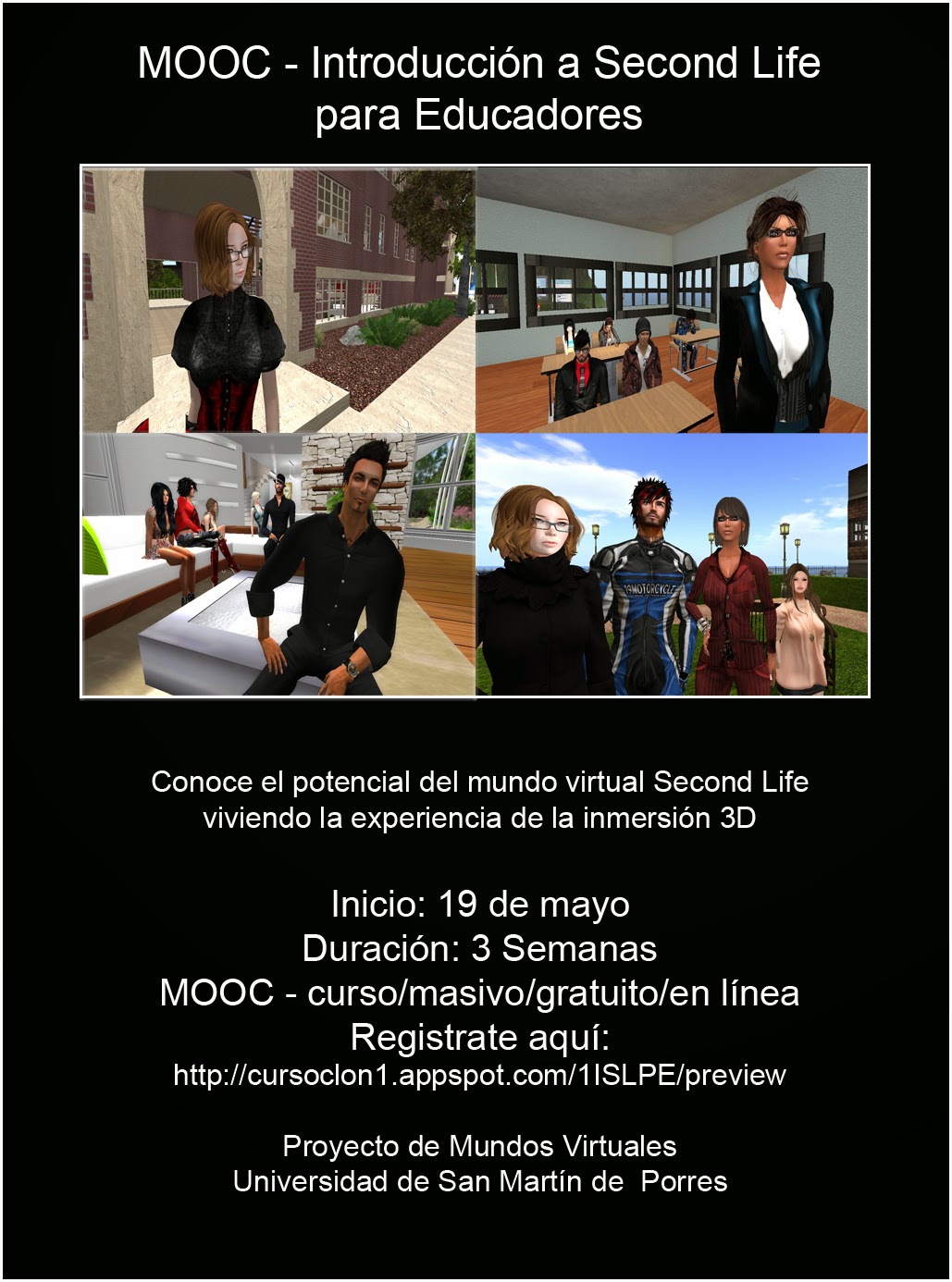Merge methodology , technological development and diffusion is not easy, but it is innovative, and that is the reason for implementing a MOOC course (massive open online course) .
The Virtual Worlds Project of the University of San Martin de Porres (USMP) have already announced for May 19th the start of the course, "Introduction to Second Life for Educators" on MOOC mode. This course is designed to help educators and other Spanish-speaking professionals in the use of the virtual world Second Life, as a starting point in their interaction with emerging environments that can be used for education. The course is completely free (contents, practices and evaluations) , its duration is 3 weeks and only the Digital Certification, awarded by the USMP, which is optional for those assessments has approved a fee. Registration is now open. To register simply access the course website .
http://cursoclon1.appspot.com/1ISLPE/preview
Reflections :
These days, educational institutions are increasingly adapted to this new form to implement courses, then, the question is: What makes the MOOC "Introduction to Second Life for Educators" being an innovative course?. Precisely the public to which it is addressed and the emerging technology that imparts .
Involve educators to a platform that even though its 8 years of existence, provides information , tools, and spaces to residents mostly in the context of English speaking , faces not only the language barrier, but also requires to adequate a educational methodology associated with these courses, which contemplates the effectiveness of teaching to educate.
The methodology is supported by key principles of online or distance education, such as autonomy, active , collaborative learning, student-focused , creating an environment of educational nature , generating skills, among other. (Heines et al. 2001) .
In advance of an upcoming paper on the subject, I'll give a look to the principle of autonomy considered in this course. This not only involves the use of technological means for the student to develop the activities of the course, whenever and from wherever via the Internet, but must also consider the "absence" of a teacher, ie the contents, practice activities and assessments are designed so that the student does not feel that "absence."
Rerefering to the above, I clarify, a MOOC do not lack of a teacher, but transforms the educational process into a process in which teaching and learning can not be synchronous, meaning that the teacher discovers, creates and develops in a prevous phase, offereing an expeditious course for students in a different environment, in short, a MOOC changes the time of action of teachers, but not avoid them. That is, in addition they are generally present in the forums and consultations.
Another methodological aspect included in this MOOC is measuring technology , which avoids duplicate efforts, involves the orientation to the tasks and the precision of use. All that means among other, in choosing a platform that provides a measured support for example, to assess all what is useful to us from the platform or not, taking into account the perception of the usefulness and ease of use (Davis et al. 1989); to use one communication application to enable the clear sending and reception of specific messages, that is, information management; to define what is the right tool to support and reinforce contents (videos , presentations , text, etc.) . We must consider this MOOC run into an educational web platform but complemented by entering within the virtual world Second Life.
Likewise should emphasize the trinomial - time content - activities in the programming process. Determine the time it will take the student to the attend to an entire online course with specific dates, implies at least, to define the format of the content for proper access and "consumption"; and determine the type of questions in assessments and practical requirements; making skills raised.
These reflections offer an approach to has involved the development of this MOOC course, highlighting that behind the visual part of the course there is a process that involves. both technology and methodology and is that in the right combination where lies the solidity of every course in this mode.





